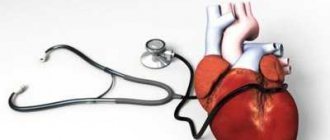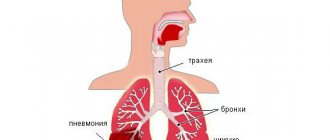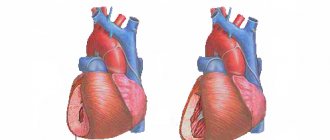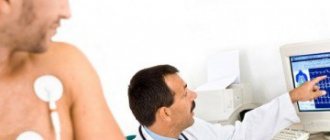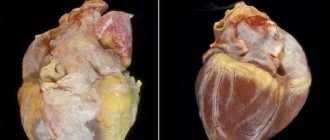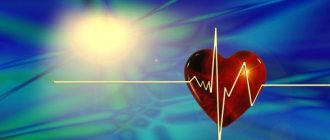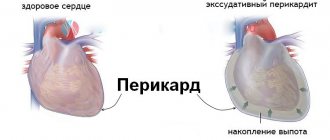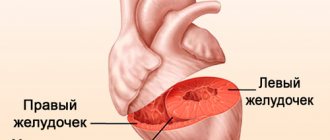What is heart palpitations?
Everyone has experienced heart failure of various types at least once in their life. It’s a very unpleasant feeling when, for a few seconds, you feel between heaven and earth, because your heart skips a beat, and it’s not at all clear whether you want to work again.
People faced with a similar problem complain that in some cases they feel a heartbeat and a feeling of lack of air. The reason for this is extrasystole - a series of extraordinary heart contractions, provoked by a number of triggers. An impulse arises in the myocardium, which in turn precedes the next blow, and the next one occurs at its proper time. The pause between beats lengthens - this causes the feeling that the heart is stopping, a state of confusion and expectation.
This condition occurs in 80% of patients over 50. Interruptions also occur in young, athletic citizens, even children. Because of this, it is customary to treat extrasystoles calmly.
Extrasystole (causes, symptoms, diagnosis)
Listen, can you feel the rhythm of your heart? Normally, you should not hear or feel its beating. If this does happen, then this is a reason to think about it and go to the doctor. Moreover, if you feel a slight blow to the chest, and then a pause, and this brings discomfort, then you are faced with an extrasystole.
In scientific terms, extrasystole is a process during which a sudden additional contraction of the heart occurs due to an electrical impulse in one of its sections. Extrasystole is the most common type of arrhythmia.
According to statistics, extrasystole is recorded in 70% of healthy people. In more than 65% of cases, ventricular extrasystoles develop, 25% are atrial, and the rest are combined variants of extrasystoles.
In its normal state, the heart contracts rhythmically, impulses are generated regularly, the sinus node and the electrical signal move according to the direction, down to the ventricles. But when the work of the heart is disrupted, a premature electrical jump occurs - an extrasystole. After it there is a pause, and then the heart begins to beat rhythmically again.
How does the heart's electrical system work? The sinus node is the main conductor of rhythm; its electrical signal is distributed throughout the atria, lingers slightly in the articular node and spreads throughout the ventricle.
During extrasystole, the sinus node temporarily stops functioning, because of this, the heart seems to turn off for a moment, literally freezing. Then an electrical surge appears in the ventricle and a contraction occurs, the heart begins to beat again, and the rhythm is restored.
What is premature contraction? This is a heart condition in which the heart beats earlier than it should. When the heart functions normally, the organ fills with blood. And when an extrasystole occurs, its work is suspended for a split second.
Diagnosis and treatment
Since cardiac extrasystole has no obvious signs, it can only be detected by conducting a preventive examination.
If symptoms are still present, then it is necessary to undergo daily ECG monitoring by installing a Holter monitor. He will count the number of extrasystoles per day and help determine their source.
If a patient has more than 20,000 extrasystoles per day and has a disease of the cardiovascular system, then treatment is necessary. And if there are up to 20,000 extrasystoles, and he does not feel them, then treatment is not required. If the patient has only 100 extrasystoles, and he experiences discomfort, then treatment is required.
The number of extrasystoles is not so important as the patient’s sensations during them.
There are several types of treatment, depending on the patient's baseline health. Only a doctor can offer a competent solution based on examination and tests. But as general information, we can give several options.
If, in addition to extrasystoles, a serious heart rhythm disorder is detected in the patient, the doctor may prescribe the installation of a pacemaker and defibrillator. They will help prevent rhythm disturbances.
Treatment of extrasystole in a patient who does not have heart disease usually comes down to the prescription of antiarrhythmic drugs and recommendations for maintaining a healthy lifestyle.
Extrasystole, as an independent disease, does not carry dangerous consequences. However, when cardiac arrhythmias occur due to pathology, complications may arise. For example, the development of atrial fibrillation, which we wrote about earlier.
This disease means that the atrium begins to contract erratically with a high frequency and low amplitude. The ventricles begin to work in an incorrect way.
Atrial fibrillation is dangerous to health, since heart rhythm disturbances can be asymptomatic, detected accidentally or during a routine examination. The lack of preventive factors leads to the fact that a person cannot control the consequences, such as blood clots or stroke.
The Chernaya Rechka Heart Medicine Center employs professional cardiologists from all over our country. We not only treat arrhythmia and other heart diseases, but also help to adapt to life after them.
Take care of your health and don't get sick!
Source: https://www.cardiokurort.ru/encyclopedia/445-ekstrasistolia
Fading heart: causes of pathology
When your heart skips a beat and your breath catches, you don’t think about the provoking moment. But as soon as the situation returns to normal, the reasons why the heart skips a beat come to the fore.
The causes of interruptions in the heart muscle are well known and are divided into cardiac and extracardiac.
Cardiac causes: IHD, including angina pectoris, AMI, coronary atherosclerosis, heart failure, valve defects, hypertension, myocarditis and other inflammatory processes in the myocardium, mediastinal tumors, infections of the membranes of the heart muscle, cardiosclerosis, cardioneurosis, immune pathologies of the myocardium, rheumatism.
Non-cardiac causes: electrolyte imbalance, medication, alcohol and nicotine intoxication, pathologies of the endocrine system, osteochondrosis, visceral obesity, diseases of the nervous system, anemia.
Treatment methods
It sounds strange, but such a problem is sometimes treated with just a regular visit to a psychologist or psychiatrist. The essence of the technique is to remove the patient from a depressive or anxious state, which adversely affects the functioning of the heart.
In practice, drug treatment is also carried out. To do this, you will need to see a cardiologist who will prescribe medications:
- to maintain normal production of adrenaline in the blood;
- used for arrhythmia;
- replenishing calcium levels in the body.
And, as always, do not forget about the folk recipe. It is often prescribed by doctors. For example, to treat extrasystole of the heart muscle, you can use the following recipes:
- Make a hawthorn tincture. To do this, you need to fill the hawthorn with water and leave for 10 days. Take the resulting mixture three times a day, 10 drops.
- Valerian tincture is used in a similar way. To prepare it, pour a few teaspoons of the plant with boiling water in a volume of 100 ml and cook for 10 minutes.
If the heart seems to be tumbling and all of the above treatment methods are ineffective, doctors resort to surgery. To do this, a special catheter is taken, with the help of which special impulses are sent by radio frequencies, necessary for the correct heart rhythm.
FacebookvKontakteTwitterWhatsApp
Symptoms and clinical manifestations
If the feeling of a sinking heart is accompanied by the following symptoms: discomfort or pain behind the sternum, shortness of breath, heaviness in the chest area, unproductive cough, weakness, deterioration in performance, vertigo, cephalgia, a feeling of missing beats, paroxysmal attacks, decreased cognitive functions, urgent medical consultation is needed. Symptoms of a sinking heart can be caused by a malfunction of the nervous system or heart muscle.
First aid
If the heart stops and then a strong beat follows, this is a sign of developing paroxysmal tachyarrhythmia. The onset of an attack is accompanied by: severe weakness and dizziness, shortness of breath, a feeling of stopping, a feeling of cardiac arrest, a change in the rhythm of heart contractions.
The first thing to do is to calm down, distract yourself with something, just breathe deeply. If the pulse goes off scale beyond 120, there is no time to think, you need to call an ambulance. Before the doctors arrive, the person must be ensured complete rest by placing him in a comfortable position on the bed (with the exception of cases with shortness of breath, then the patient must be seated), give access to fresh air, loosen tight clothing, ask him to close his eyes and press on his eyelids - this will slightly normalize the pulse . You can give sedative drops. In the worst case scenario, it can cause vomiting. If the condition worsens, artificial respiration and closed heart massage may be necessary. This will save a person's life.
How and with what to treat?
If the heart turns over and stops, but interruptions in the rhythm are isolated, occur rarely, there are no other symptoms, there is no need to treat extrasystole. This is a functional state caused by drinking too much coffee, alcohol, or stress. In women - menstruation. In people with VSD, asthenics, this is also a common occurrence, but it is they who have a particularly difficult time with heart failure.
Instead of medications, you need a healthy lifestyle, no stress, and avoidance of stimulants like coffee and alcohol. Products with magnesium and potassium will help with this: cereals, lettuce, persimmons, dried apricots, citrus fruits.
If, along with freezing, you catch your breath, the heart stops for a couple of seconds, and all this against the background of an existing cardiac pathology: ischemic heart disease, heart defects, cardiomyopathy - medication is required.
Even harmless extrasystoles in this case can seriously aggravate the course of the underlying disease and pose a threat to life, since they provoke fibrillation of the atria or ventricles of the heart muscle. Treatment is also necessary when the patient has more than 200 extrasystoles per day: the release of blood from the heart chambers decreases, which disrupts the blood supply to the brain and other internal organs.
It is worth noting that sometimes the feeling of a sinking heart itself does not require treatment, but is a sign of another pathology, which without treatment can cause a fatal outcome: advanced hyperthyroidism, myocardiopathy, cardiosclerosis.
If cardiac arrest is associated with atrial fibrillation, the situation is aggravated many times over, since atrial fibrillation is the cause of stroke.
Classification of beats in the heart
The problem in most cases begins in the ventricle (60% of diagnosed cases) or atrium (25%). With pathology of the heart muscle, an incorrect impulse leaves the sinus-atrial node, which is responsible for the coordinated functioning of the organ. Attacks vary in frequency:
- rare (less than 5 times in 1 minute);
- medium (from 6 to 15 times);
- frequent (more than 15 times per minute).
The medical classification of tremors in the heart area is based on the affected area, from which the irregular rhythm emerges:
- Supraventricular: freezing is provoked by an area outside the organ. The atrium and the valves that regulate blood flow are responsible for the problem.
- Ventricular: a more severe form of pathology, which is often complicated by failure and arrhythmia. Excitation begins inside the organ and spreads in waves along the walls.
Depending on the cause of the tremors, cardiologists offer the following division, which facilitates diagnosis:
- Organic: the risk factor is always diseases of the internal organs, pathologies of heart development. In this case, extrasystole can be congenital and accompany defects, or acquired during a heart attack or ischemia.
- Functional: tremors provoke problems of the human nervous system, exacerbation of autonomic pathologies. The reasons may lie in malnutrition, lack of essential vitamins and amino acids.
If the patient feels a single blow from the inside, we are talking about a single focus - monotropic. With multiple spasms, a polytropic form of the disorder is suspected.
